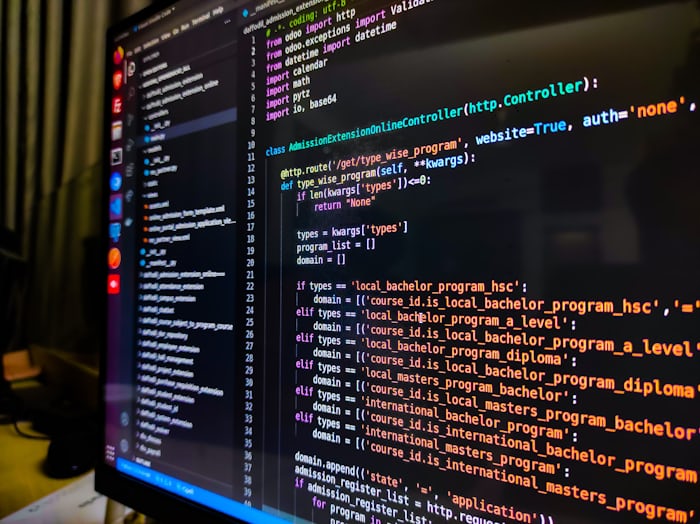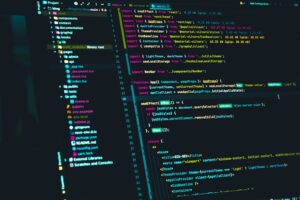
Computer Programming
We want to cover the fundamentals of computer programming in this post, which will guide you through a series of some segments that you may use to master any and all programming languages.
We’ll begin by addressing the most basic query: what exactly is programming? From there, we will gradually increase our level of discussion as we go over fundamental concepts in computer science like loops and arrays, as well as how to read and write code, debug code you’ve written, organise your code, and much more.
If you’re familiar with some aspects of computer science previously or if you’re just curious about a particular subject we’ll be addressing. By the ends of this article, hopefully, you will have a fundamental idea of what computing science is, in addition to a variety of practical abilities that will support you in learning any programming language you choose. First, we’ll limit our discussion to the salient features that are relevant to all programming languages. For that reason, we won’t be covering language-specific subjects like object-oriented coding and command line navigation.
what exactly is programming, which is presumably the main issue on your mind.
According to the word, it’s the act of getting a lesson plan ready for a gadget. But that definition is rather ambiguous. What does that mean, exactly, in plain English? In essence, it’s trying to teach a computer to perform a certain task error-free.
Consider the following scenario: you want your less-than-intelligent friend to assemble a Lego set, but he doesn’t have the instructions and can only do so at your order. But keep in mind that your friend is far from skilled. Because of this, there are a lot of mistakes that they could make if they are not provided very detailed directions on how to create the set.
Giving your friend instructions isn’t the only thing programming involves these days. As the computer does not speak the same language as you in the case of a coder. The only language that the computer can comprehend is machine code, which is a binary numerical language created so that the machine can read and process instructions quickly. The computer interprets each instruction it receives as a series of ones and zeros before using that string to perform a task.
Returning to the Lego example, if he were not simply less than intelligent, this procedure would not have occurred. To exacerbate the situation, he only speaks Mandarin Chinese and is incapable of understanding English. You must translate the instructions that you comprehend in English into the language that your friend understands in order to communicate with him.
In essence, this procedure is what you have to do to get your computer to comprehend the commands you give it. The main distinction between the two instances, though, is that binary machine code is extremely challenging for humans to comprehend.
It is highly difficult, if not impossible, to directly translate what you want the computer to do into machine code. Even if it were feasible, it would take a very long time to do. Millions upon millions of such ones and zeros make up every programme. Thus, how precisely are we to convert our instructions into machine code? Programming languages are useful in this situation.
In essence, programming languages act as a mediator between a programme and machine code. These languages are particularly helpful for programmers since they are far simpler for people to understand than machine code. Recalling our Lego example, a programming language may be thought of as an interpreter that can convert instructions you give it in English into instructions your friend who doesn’t speak English can comprehend. Because of this, programming languages are very helpful and the foundation of every well-designed software. Consider programming languages to be somewhere in between machine code and English.
Types of Programming Languages

There are numerous programming languages available, and each has a special application. Python and Java, for example, are general-purpose languages that may be used for a wide range of computing activities. Other languages, for robotics C, HTML, and CSS, are meant for more specialised tasks, like building a website or driving a robot.
Languages might differ in terms of power as well. For example, JavaScript is a programming language meant for simpler tasks, whereas Python or Java can handle far more computationally intensive jobs. The degree to which a programming language resembles machine code—the string of zeros and ones we discussed earlier—is a good way to gauge its power or level. Compared to high level programming languages like Java or Python, low level languages like assembly or C are more similar to binary.
The core concept is that your code will resemble what a computer can understand as instructions more closely the lower the level of your programming language. Aside from the various functions that each language does, selecting a language is usually a question of taste because there are typically several languages that can carry out comparable activities. Try a variety of languages, then select the one with the best rule interface and degree of simplification.
How to Gain Mastery on Writing Computer Programs (Coding)

Now that we understand the definition of programming, how do we really write code? It seems like we can just input text into a document and expect that the computer will be able to read it, convert the words into machine code, and do operations like opening a browser. Furthermore, we cannot simply write garbage in the programming languages that were covered in the preceding section and expect the machine to comprehend it. That being said, how are we to write code then?
The solution, then, is with an ID. And an integrated development environment, or ID for short, permits a computer to facilitate the writing of code. It gives the programmer easy access to a graphical interface on your computer so they can write, execute, and debug code without worrying about complex or interpreted programmes.
To create code, imagine an ID as any other computer programme, like a gaming browser or even the file explorer. IDs can convert your code into machine code, which can then be run by the computer to generate output. As we’ll discuss later, code doesn’t always execute correctly, therefore in addition to giving programmers a space to create their code, IDs also offer some incredibly helpful tools to make creating code easier. One such tool is built-in error checking.
You may arrange and work with the files in your project more easily with the help of auto-filling for commonly used words or phrases and a project hierarchy. Before IDs, codes had to be typed on punch cards and then input into computers, a process that took hours and was very painful. These days, IDs simplify things greatly for programmers and serve as a kind of fast lane to writing code.
You are currently viewing an example of a certain ID on your screen. The programme that is now being written is visible in the centre. The console, which can spit out helpful information for programmers, is located directly beneath it. To write Java code, one needs to use this particular ID. You will almost certainly use IDs in all of your programming projects because they are really strong.
Also Read: 7 Emerging Technologies That Will Revolutionize Humanity
We may now write and compile code without fearing that the machine won’t be able to understand it thanks to these IDs. The next issue that arises is how to enter this code into the ID. The syntax of a programming language is used because, well, we can’t just input words from a programming language and expect the machine to understand them. Now, studying a computer language can be somewhat similar to learning a real language. Some people have unusually distinct styles.
Like all languages, programming languages have a set of rules that you must abide by when writing code, and grammar is at the forefront of those rules. Programming grammar is also known as syntax, and it is very similar to real world grammar. However, some programming languages may require you to use strange or abstract concepts that may be confusing.
Just like when you speak in real life, each programming language has specific rules or syntax that you must adhere to exactly if you want your programme to function properly. These can include things like the how you type out specific functions, what you put at the end of a code line, and how you configure specific functions. Every language has a different syntax; some may have rules that are similar, but each will have some peculiarity that sets it apart from the others.
Many individuals are surprised by syntax because they assume that all computer languages have the same set of rules. However, as we discussed in the previous section, each language has its own set of rules in order to work because it is specialised for a particular goal. Errors will occur if these guidelines are broken or ignored. Similar to how disobeying or breaking the law in real life can have an unexpected consequence.
For illustration, let’s say you wished to initialise a variable. This is a basic task that we haven’t yet addressed, but the example holds true. You’ll see that when declaring a variable in Java, we have to declare its type—in this example, an integer—and add a semicolon to the end of the sentence. In Python, all we have to do is specify what we want to construct—we don’t even need to define that we are trying to create a variable. Additionally, unlike Java, we just state that a variable is being created in JavaScript; we do not define the kind of variable that is to be created.
You can see how important grammar is while learning a new language even from this basic example. Although our program’s objective—defining an integer with the value three—remained constant, the methods used by the various programming languages were distinct. Remember, these languages all need you to utilise this syntax because computers are very simple machines. The programme won’t run at all if you miss a single semicolon or a character, and you’ll receive a syntax error message that we’ll address later.
Consider this as though you were attempting to convey something, but you forgot to comma and the entire sentence was misconstrued. For instance, in the phrase “let’s eat grandma.” Should you overlook that comma. Though it might seem like a little error, it completely alters the meaning of the sentence, giving the impression that you’re going to devour your grandmother. The guidelines for programming are the same. The ID may become distorted and misunderstand your program’s context if you omit a semicolon.
Now, the fact that they will notify you if and when there are syntactic issues in your code is another feature that makes it so helpful. Syntax problems are, of course, elements of your code that do not adhere to the same guidelines as we discussed earlier. The ID will identify the flaws in your code and prevent you from running your programme until the problem has been rectified.
The significance of syntax in learning a new language and developing code. Before writing intricate programmes in a language, it is advised that you become familiar with its grammar and norms. Most of the rules are simple to understand yet time-consuming to learn. And as soon as you can accomplish that, you’ll be producing code in no time at all and be able to recognise and fix syntax issues with ease.
That summarises the fundamentals of programming rules and grammar. We now know where and how to create code, so let’s go on to discussing what happens when we run our code and type out our programme.
Because it’s cool and everything to write code for a game or database. But how will we be able to determine what’s going on and whether the programme is functioning once the computer has interpreted it? To do this, programmers simply need to glance at the console. Your computer’s console is a text interface that programmers like us can utilise for a wide range of tasks.
As you recall, we heard about an image of a simple ID not too long ago. The console was also a prominent feature in the image. Text output from the programme is the console’s primary function. Typically, a print statement is used for this. A print statement is a command that performs its name exactly. Text is printed to the console by it. The first real piece of code we’ve discussed in this series is the print statement. It is nearly as easy to understand as the print statement.
Even though it’s so basic, is one of the most crucial features of programming and can be found in almost all programming languages. Making the print statement say something is the simplest thing you can ask it to do. To accomplish this, put wherever you want to be printed inside the brackets and tell the console to print. For instance, the Python code print hello world will result in the console displaying HelloWorld as a message.
Quite nice. Additionally essential for examining and understanding the computer’s output from the programme is the print statement. For example, if you could programme a computer to perform a basic computation. For instance, they will execute the programme inside and compute the solution to find four plus three. Instead of just telling the computer to do this calculation, tell it to print the program’s output to the console. When the programme finishes, seven will appear on the console. After all, what good is having the computer run this programme if you can’t tell what the result is?
As you can see, we can quickly print information to the developer for a number of purposes using the console. It’s crucial to remember that the print statement differs based on the programming language being utilised.
For instance, in Java, there are various print statement variations based on whether you want a line break to appear after the text is printed. You can also use specialised print statements to optimise the performance of your code.
In addition, different languages have different print statement syntaxes and subtle differences in how they work. However, as it is a fundamental statement for programming in general, you can usually count on it to do the same general function. All of its features, including the console and an extremely helpful development tool, make a statement when printed. But it’s crucial to keep in mind that the developer tool is just that. It is not actually intended for the end user of your programme to access the console.
Consider it this way: information is typically displayed to the user through other means, such as text, graphics, or images; it is typically concealed away behind the scenes. You see the console and none of your favourite apps when using your phone. Thus, even while you can use the console to see how your programme is doing, it’s not really intended for that use case, so don’t try to incorporate it into the finished output.
All things considered, keep in mind to make the most of the console when creating and resolving issues with your programmes because it’s a fantastic resource for learning about the inner workings of your software.
Some Tasks that the Computer can Complete on its own Without your Assistance

After learning a great deal about programming languages, where and how to write them, and how to use the print statement, let’s review some basic tasks that the computer may perform on its own without direct instruction. More precisely, string maths and some fundamental number theory will be covered.
To begin with, the computer is already capable of performing fundamental arithmetic. This covers addition, subtraction, multiplication, and division, all of which are represented by the symbol that is currently displayed on the screen. With the print statement, you may print out the solutions to basic math problems in any ID that you may install.
Which may sound contradictory given that you have a perfectly decent calculator on your phone; why would you need the computer for math calculations? However, keep in mind that computers are not very intelligent. Furthermore, we have to start from zero if we want a computer to perform a task.
While simple, basic arithmetic comes in handy when writing nearly any programme. When our user tries to add, subtract, multiply, or divide two integers, for instance, we would need to employ this capability in order to display the proper answer to an arithmetic issue in our basic calculator app.
Now, most programming languages also provide an additional operator called modulus in addition to the four fundamental math equations. Don’t worry if this is your first time hearing the word; maths classes don’t typically teach it. We can obtain the remaining value of a divisional operation using modulus.
For instance, when we take 10 modulus 3, we are effectively instructing the computer to take 10 divided by 3, ignore the real result, and provide us with the remaining part of the calculation. In this instance, one, as the remaining is three when we divide ten by one.
The one that is printed onto the console in this instance. If we were to print the result of a function to the console and there was no remainder, for example, if we took 50 modulus two, the function would return zero because there is no residual. This can be really helpful. The most obvious example of this is when we wish to find out if a given integer is even or odd.
Since every integer divided by two always yields a complete answer without a remainder, we can determine that a given number, modulus two, is even if it returns zero. You’ll find yourself employing the fundamental math operations far more frequently than you might imagine, yet, if the system returns one, in which case we know the integer is odd. Therefore, it’s a good idea to consider them when using your programme.
Our computer can now operate not just with numbers but also with strings.
By the way, strings are just another word for text. Programming languages designate anything wrapped in quotation marks as a string. Examples of strings are hello world and the letter A. When we discuss variables later, we’ll go into further detail regarding strings. But let’s go forward for now.
The topic of printing strings to the console has already been covered. However, suppose we were creating a game and wanted to print out the message “Game over” for the amount you scored at the end. It might be more helpful in some situations to print out the real integer value rather to merely creating a string that says that identical phrase and sending it to the terminal. This is especially true for games where the score varies with each play.
Also Read: 2050: The Prospects for Brain-Computer Interfaces
Since the score isn’t going to be for everything all the time. By combining them together in the print command, we can also print out several text strings and even integers. We call this concatenation. Keeping with our scoring example, we could use four as an integer instead of a string if we wanted to print out the message “gameover” for your final score. This could be accomplished by decomposing the statement into, say, two strings and an integer. Your ultimate score was four plus print game over.
Additionally, printing our statement in its whole is a simple process. By using this, we can quickly print out a variety of texts and integers in a single print statement. The two lessons we’ve learnt so far might also be combined, and the result could be something like “game over plus four plus four plus was your final score.” For example, let’s imagine you are playing a game where you get a base score and extra points for completing specific tasks.
This example also illustrates another crucial feature of programming, which is that combining different parts of code is frequently necessary to make your programme as efficient as possible. Now, it’s crucial to understand that the computer will print out everything you type within parenthesis, character by character. Programmers frequently overlook adding a space at the end of their strings.
This might lead to a minor error where the string from the previous example would print out as if “gameover four was your final score,” which would not seem very nice to the user when they see it on the screen. Therefore, it’s a good idea to always leave a space before and after your strings to ensure that nothing like that happens to your string. The distinction between four with quote marks and four without is another crucial point to remember.
Instead of being interpreted as a number, a four enclosed in quote marks is now interpreted as a string. Although it might not seem significant, remember that computers are stupid. Additionally, an error will be returned if you attempt to do math with a number enclosed in quote marks. Due to the fact that programming prohibits adding numbers to strings, the computer interprets your attempt to execute the operation on a number as an attempt to add an integer to a string.
Because of this, when you’re programming, be sure to mentally remember whether you want to make anything an integer or a string—such details matter a lot. Alright, that brings an end to our discussion of computers’ fundamental power. The topic we will be discussing next is one of the key elements of computer science.
The Most Important Components of Computer Science

1. Variables
Thus, take close attention since we’ll be talking about variables next—what they are and how we use them. To begin with, what precisely is a variable? All that is required for something to be a variable is the ability to store, retrieve, and modify data. Consider variables similarly to a cardboard box. Cardboard boxes are used by servers to hold stuff that can be changed, substituted, and modified variables are similar to cardboard boxes in that they store data that can be accessed or altered by programmers.
All variables contain are a type, a name, and some data that is stored within. The name is just a name for the variable; the type and piece of information will be discussed next. Consider it as labelling the cardboard box with a Sharpie.
Although a programmer can utilise a wide variety of variables, for the sake of this discussion we will only be discussing what are known as primitive variables, which include integers, Boolean, floats, doubles, strings, and characters. Let’s begin by discussing an integer. As straightforward as it seems, an integer, or int for short, is a variable that has the ability to store an integer value. All whole numbers between minus 2,147,483,648 and 2,147,483,648 are included in this.
As you can see from what I said, integer values cannot and will not retain decimal values. Therefore, when utilising variables, bear that in mind.
2. Boolean.
A very basic variable that may hold the values true or false is called a Boolean. Only these two values can be stored in boolean variables, which are very helpful for conditional statements—a topic we shall discuss shortly. The next two categories of variables are doubles and floats. Since both of these variable types are floating point data types, they can both store numbers up to six decimal places.
Doubles and floats can store decimal values, while integer values cannot. The ability of a float variable to store integers with precise precision up to 32 bits is the primary distinction between the two. All doubles have a 64-bit precision limit when storing numbers. In essence, a double has a larger decimal place storage capacity than a float. Therefore, everything depends on how exact you require the variable to be.
3. String variables
Raising The strings we’ve discussed previously are similar to string variables, which are the next topic, except they are stored someplace in a value. Strings of letters, or words and sentences, can be stored in string variables. Strings can be used to store input data and display text. Additionally, strings can be joined together to create new combinations of pre-written strings and string variables.
When information needs to be output in a legible format for the user, this can be quite helpful. Consider the following scenario: we have a string named name. The code requested that the name and text string be entered and stored. to provide the user with this information. You can add the phrase “Your name is” and concatenate it to form a sentence instead of just displaying their name. You are plus a name plus a period in your name. This adds unpredictability to your code, which always makes things more interesting for the end user, and makes your code easier to read.
4. Char Variables (character variables)
Lastly, char variables are included. As the name implies, they can each hold one character. Char stands for character. When a programmer wishes to read a single button push or a single character in a string without using a string variable, this is helpful. One particular example would be a keyboard-controlled game where the application must identify the character being pushed and transform it into a certain action.
Strings can now hold a single character, but characters can hold several characters. Therefore, when defining variables, bear that in mind. So why are variables so helpful now? All good programmes must have the ability to store data in a format that makes it easy to retrieve it later. You’ll frequently wish to record information in code, like the name of the user or their score. This information is therefore stored in a variable you create called name or score, which you can then refer to, edit, or add to.
Additionally, the programme will frequently request user input, which cannot be preprogrammed into the code and necessitates the usage of variables to hold the data. Programmes may also be dependent on variables that vary as they go along, in which case a variable is needed once again. Additionally, changing these variables is essential to completing many of the activities you want your programme to perform.
For example, concatenating string variables or multiplying in variables. The foundation of any programme is its overall variables, which you will find yourself using frequently if you wish to write clear, effective code. Therefore, it’s advisable that you understand the kinds of variables you need to apply and when.








